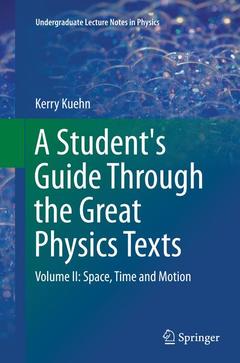Description
A Student's Guide Through the Great Physics Texts, Softcover reprint of the original 1st ed. 2015
Volume II: Space, Time and Motion
Undergraduate Lecture Notes in Physics Series
Author: Kuehn Kerry
Language: English
Keywords
analysis of foundational physics texts; collection of major physics texts; foundational science texts; foundational texts in physics; great physics texts; history of science book; history of science textbook; important physicists; important texts in physics; introduction to astronomy; introduction to cosmology; physics and astronomy text; physics history textbook; science of motion; significant developments in physics and astronomy
Publication date: 08-2016
Support: Print on demand
Publication date: 09-2014
380 p. · 15.5x23.5 cm · Hardback
Description
/li>Contents
/li>Biography
/li>Comment
/li>
This book provides a chronological introduction to the science of motion and rest based on the reading and analysis of significant portions of Galileo?s Dialogues Concerning Two New Sciences, Pascal?s Treatise on the Equilibrium of Fluids and the Weight of the Mass of Air, Newton?s Mathematical Principles of Natural Philosophy, and Einstein?s Relativity.
Each chapter begins with a short introduction followed by a reading selection. Carefully crafted study questions draw out key points in the text and focus the reader?s attention on the author?s methods, analysis, and conclusions. Numerical and laboratory exercises at the end of each chapter test the reader?s ability to understand and apply key concepts from the text.
Space, Time and Motion is the second of four volumes in A Student?s Guide through the Great Physics Texts. This book grew out of a four-semester undergraduate physics curriculum designed to encourage a critical and circumspect approach to natural science, while at the same time preparing students for advanced coursework in physics.
This book is particularly suitable as a college-level textbook for students of the natural sciences, history or philosophy. It also serves as a textbook for advanced high-school students, or as a thematically-organized source-book for scholars and motivated lay-readers. In studying the classic scientific texts included herein, the reader will be drawn toward a lifetime of contemplation.
Scaling in Art and Nature.- The Coherence of Substances.- Archimedes' Principle and Falling Bodies.- Falling Bodies and Pendular Motion.- Pendular Motion and Harmony.- The Law of the Lever.- Beams, Bones and Giants.- Naturally Accelerated Motion.- The Mean Speed Theorem.- Equilibrium, Force and Acceleration.- From Conic Sections to Projectile Motion.- The Speed and Force of a Projectile.- Reason, Authority and Science.- Pascal's Principle.- Submerged Bodies.- Syringes, Siphons and Suckling Infants.- Life Under a Sea of Air.- Does Nature Abhor a Vacuum?.- Mass, Momentum and Force.- Absolute and Relative Motion.- Newton's Laws of Motion.- Conservation of Momentum.- The Third Law and the Power of Machines.- Centripetal Force and Acceleration.- Newton's Rules of Reasoning.- Planetary Motion.- Universal Gravitation.- Hypothesis and Natural Theology.- The Principle of Relativity.- The Absolute Speed of Light.- Lorentz Transformations.- Relativistic Energy and Minkowski Space.
Kerry Kuehn is Associate Professor in the Department of Physics at Wisconsin Lutheran College. He is a member of the American Physical Society and an Advisory Council member for NASA Wisconsin Space Grant Consortium and Fidelitas (WLC Honors Program).
He has designed and taught courses including "The Heavens and the Earth," "Space, Time and Motion," "Electricity, Magnetism and Light," and "Computerized Instrumentation and Design."




